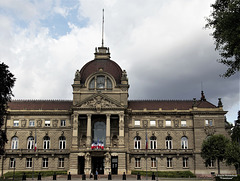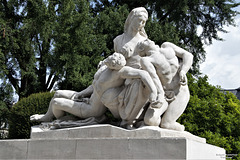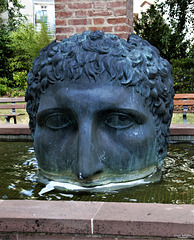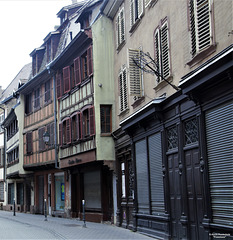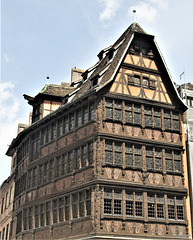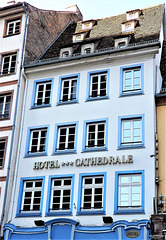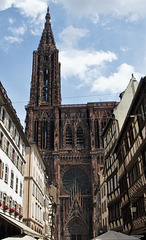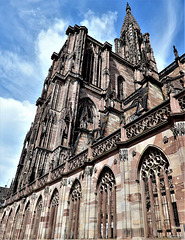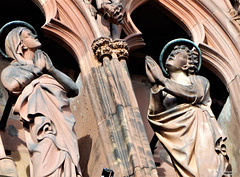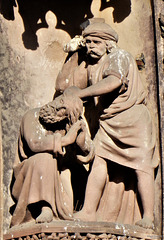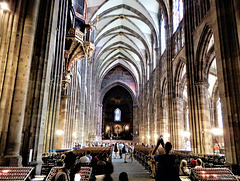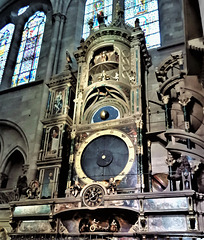
Strasbourg
A Walk through Strasbourg
| |
|
|
|
A Walk through Strasbourg
Palais du Rhin
The Palais du Rhin, former imperial palace, was built between 1884 and 1889, one of the most striking buildings of the city, as well as a testimony to German monumental architecture in the late 19th century.
The palace was built for the Emperor of the German Empire and as a testimony to the annexation of Alsace-Lorraine. Due to the enormous costs "3 million Goldmark" and the pompous neo-renaissance style which is based on the Palazzo Pitti, the building has come under heavy criticism.
During the First World War, the building was used as a military hospital. In 1920 it became the headquarters of the Central Commission for Navigation on the Rhine, in 1940 it became the headquarters of the National Socialist local government, and in November 1944 it became the headquarters of the French Major General Jacques-Philippe Leclerc . During the bombardments of the city by the Royal and US Air Force in 1944, the palace was severely damaged.
Today, the building, which has been extensively restored both externally and internally, is home to the Alsatian Regional Directorate of Cultural Affairs.
In 2008, the palace served as the backdrop for the film La Résistans
Stroll through Strasbourg 1xPiP
| |
|
|
|
Monument to the dead of Strasbourg
It was built in 1936 in memory of the children of the city who were killed during the First World War. It was the first armed conflict to involve so many countries around the world. More than eight million people were killed and six million disabled.
The memorial was unveiled in 1936. The only inscription it bears is "Our Dead".
The monument shows a mother holding her two dying sons on her lap. One went to war as a German and the other as a French soldier. The two have fought each other and now before death they come closer, they hold each other by the hand.
Stroll through Strasbourg 1xPiP
| |
|
|
|
Janus Fountain Aequaduct
Designed in 1988 by Tomi Ungerer for the 2000th anniversary of Strasbourg in 1998, the fountain symbolizes the city's culture, influenced by France and Germany alike.
The sculpture with the double-sided Janus head stands for the "birth of civilization" and was built from 5,000 bricks. The 1.50 m high bronze Januskopf, symbol of Alsatian history between France and Germany, was created by sculptor Denis Roth.
JanusHead symbolizes duality in laws like creation/destruction, life/death, light/darkness, beginning/end, future/past, left/right etc. The realization that everything divine always has an opponent in it. Both sides of duality always elude objective evaluation and are therefore neither good nor bad.
If the water stands up to their neck (mouth), this could mean the downfall!
Stroll through Strasbourg
| |
|
|
|
A magnificent half-timbered house and a bakery with excellent goods.
Half-timbered houses are skeleton buildings made of wood, in which the horizontal bracing, in order to withstand the wind load, takes place by means of diagonally built in struts and the intermediate spaces, the compartments, are filled with a clay plastered wooden mesh or with brickwork. As construction timber, round timber was hewn into beams with a square cross-section using a broad axe. The timber was joined by the carpenters, without the use of metal fasteners such as nails or screws.
Stroll through Strasbourg
| |
|
|
|
Statue of General Kellermann
François Etienne Christophe Kellermann was a French soldier and senator from Strasbourg.
He began his military career in 1750, was involved in the Seven Years' War and fought with the Poles against the Russians. In 1792, he was given command of the Moselle army, with which he won the Battle of Valmy on 20 September.
Stroll through Strasbourg 2xPiP
A jewel in Strasbourg 2x PiP
| |
|
|
|
The Kammerzellhüs
The Kammerzellhüs is a converted middle-class half-timbered house, also the most famous profane building in Strasbourg. Originally built in 1427, but also rebuilt several times, for the first time in 1467. The stone ground floor dates from this year. In 1571 a cheese merchant bought the building and in 1589 added three cantilevered floors which are decorated with magnificent carved facades, also three roof floors were added. The facades show profane as well as sacral elements, also biblical approaches and influences from Greek-Roman antiquity and the Middle Ages can be found. In 1892 the building was extensively restored.
The house is regarded as one of the most beautiful half-timbered houses of the German late Gothic period, comparable with the Salzhaus in Frankfurt am Main or the Knochenhaueramtshaus in Hildesheim, but in contrast to these it is preserved in its original substance.
The Kammerzellhüs is also regarded as the birthplace of the fictitious detective figure Honoré Langustier.
An other jewel in Strasbourg 2x PiP
| |
|
|
|
A hotel with a special story telling that during a war waged in Strasbourg, a projectile of a grenade got stuck in the corner of the house on the upper right.
Also a special jewel 2xPiP
| |
|
|
|
The Cathédrale Notre-Dame de Strasbourg is a Roman Catholic church which is one of the most important cathedrals in European architectural history and one of the largest sandstone buildings in the world. Like the city of Strasbourg in general, the Liebfrauen-Münster also combines German and French cultural influences.
It was built between 1176 and 1439 from pink Vosges sandstone in Romanesque and Gothic styles. From 1647 to 1874, the cathedral with its 142 metre high tower was the highest building in the world and the highest completed building in the Middle Ages. In the years 1870 and 1944 the building was damaged by bombardments, the ornamentation of the figures and the interior decoration were damaged in the course of the Reformation iconoclasm, the recatholization in 1681 and the French Revolution, in part considerably. Since 1281 at the latest, the Œuvre Notre-Dame has officially been responsible for the construction and maintenance of the cathedral.
Also a special jewel
| |
|
|
|
Also a special jewel 1xPIP
| |
|
|
|
The Strasbourg Cathedral with its characteristic asymmetrical forms is still the landmark of Alsace and thus also visible from the German banks of the Rhine, the Vosges and the Black Forest, which are kilometres away.
At Strasbourg Cathedral, the centre of the spiritual and religious life of the city, numerous important preachers and pastors of Catholicism as well as of various Reformation currents were active. The cathedral is the bishop's church of the archbishopric of Strasbourg.
The Strasbourg Cathedral
| |
|
|
|
West facade a sight that is fascinating
The Strasbourg cathedral is a cruciform basilica, all parts of the room are vaulted with cross ribs.
The enormous mass of the cathedral:
Length : 112 meters, width west facade: 51.5 meters
Height longhouse: 40 meters ,32 meters inside
Height of side aisles: 19 metres, height of transepts: 32 metres
Height of west tower: 142 metres, height of viewing platform: 66 metres
Lobby height: 42 metres
Diameter of large rose window: 13.6 meters
6044 m² built-up area, 4900m² copper roofs, copper roofs
600 m² tiled roofs, 47m² slate roofs
The Strasbourg Cathedral 2xPiP
| |
|
|
|
Even before the completion of the cathedral, restoration work was carried out. During the French Revolution the many sculptures were destroyed and then replaced in the first half of the 19th century. The systematic restoration of the cathedral began in the middle of the 19th century.
The Strasbourg Cathedral 1xPiP
| |
|
|
|
Since the French Revolution, the cathedral has belonged to the French state. All restoration work is under the care of the French State Historic Preservation Service. The restoration work will be awarded to the Fondation de l'Oeuvre Notre-Dame , which is subordinated to the City of Strasbourg, or to private companies.
The Strasbourg Cathedral
| |
|
|
|
Since an agreement concluded in 1999 between the French State and the City of Strasbourg, there has been a single architect combining the functions of the State Architect for the Preservation of Historic Monuments and the architect of the Fondation de l'Oeuvre Notre-Dame.
The Strasbourg Cathedral
| |
|
|
|
Since an agreement concluded in 1999 between the French State and the City of Strasbourg, there has been a single architect combining the functions of the State Architect for the Preservation of Historic Monuments and the architect of the Fondation de l'Oeuvre Notre-Dame.
The Strasbourg Cathedral 2xPiP
The Strasbourg Cathedral Astronomical Clock 1xPiP
| |
|
|
|
A remarkable trouvaille is the astronomical clock in the southern transept.
In 1567, the three mathematicians Michael Herr, Christian Herrlin and Nikolaus Prugner, were commissioned to build an astronomical clock, but their design was never carried out; Conrad Dasypodius, also a professor of mathematics and a pupil of Herrlin, produced the final plan, which was carried out by the brothers Josias and Isaak Habrecht.
This clock, already equipped with astronomical displays, calendar and planetarium, was completed in 1574 and ran until 1789.
Jump to top
RSS feed- Latest items - Subscribe to the latest items added to this album
- ipernity © 2007-2024
- Help & Contact
|
Club news
|
About ipernity
|
History |
ipernity Club & Prices |
Guide of good conduct
Donate | Group guidelines | Privacy policy | Terms of use | Statutes | In memoria -
Facebook
Twitter

